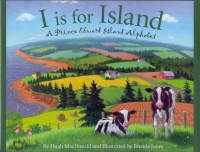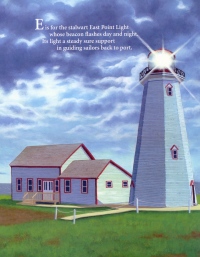| ________________
CM . . .
. Volume XIX Number 1. . . .September 7, 2012 
 |
I is for Island: A Prince Edward Island Alphabet.
Hugh MacDonald. Illustrated by Brenda Jones.
Ann Arbor, MI: Sleeping Bear Press, 2012.
40 pp., hardcover, $17.95.
ISBN 978-1-58536-367-4.
Subject Headings:
Prince Edward Island-Juvenile literature.
Alphabet books-Juvenile literature.
Grades 2-6 / Ages 7-11.
Review by Megan Sorenson.
***1/2 /4
|
| |
|

excerpt:
L is for Lobster, a true Island treat
the sweetest shellfish that you'll ever eat.
Fresh from the ocean, then into the pot,
served on a plate, from the shell, piping hot.
There are two lobster seasons in PEI. The first runs in the east through May and June, the second, in the west from mid-August until the beginning of October. Most Island fishers use single-keeled Cape Islander fishing boats with a flat bottom and a deck with a high step up toward the bow.
Traditional Island lobster traps are built by the fishers themselves of wood and twine but other materials are used as well. Traps are baited with flounder, herring, and mackerel. Lobsters climb backward through wooden rings in the knitted heads and, once inside, the larger ones cannot escape. Undersized lobsters can exit through a smaller opening in the parlour of the trap. Careful measurements are made to ensure that lobsters are of legal size.
Setting day is the most exciting day of the year for fisherfolk and their community. With boats piled high with traps, the crews begin arriving around 4:00 a.m. They race out together at 6:00 a.m. to arrive first at the best fishing grounds.
And don't forget the Island's famous lobster suppers—a well-deserved treat after a long day of fishing!
With I is for Island: A Prince Edward Island Alphabet, Sleeping Bear Press presents another great addition to its series of Canadian alphabets. This beautiful picture book follows the same format as its predecessors: each letter of the alphabet gives rise to a four-line poem about an important aspect of Island life, while a more detailed topic summary can be found in an accompanying sidebar. Readers who are familiar with the series will already know that I is for Island is not a concept book that aims to teach the 26 letters to young readers. In this text, the alphabet is merely a fun and convenient format for organizing a wide variety of topics related to Prince Edward Island.
The diverse topics presented in I is for Island give a rich and varied picture of the province. There is a nice balance of historical figures and events (the Yankee Gale, Jacques Cartier, the Prince Edward Island Railway), natural attractions (beaches, Northumberland Strait), man-made structures (Dalvay-By-the-Sea, the East Point Lighthouse, Charlottetown), outdoor pursuits (ice sports, kayaking, trails for hiking and cycling), local food (potatoes, strawberries, lobster), and, of course, literature (Anne of Green Gables makes an appearance under "M is for Lucy Maud Montgomery"). Readers from outside of PEI will learn about such interesting aspects of regional life as Old Home Week, quahogs, lobster setting, and the science behind the Island's famous red soil. The text does a particularly excellent job of blending historical and modern information about the Island. Another notable strength is that representativeness has been privileged over the alphabet structure of the text; the letter 'A' is doubled to cover two important concepts: Abegweit (the original Mi'kmaq name for PEI) and the Acadian deportation.
Both the author and the illustrator have roots in PEI, and their knowledge and love of the province are evident in this work. Poet laureate
MacDonald
skilfully plays with different metre and rhyme schemes in the book's 27 poems, creating the sense that the text is composed of a series of individual word pictures, each with their own mood and pacing. Certain lines will not ring true for child readers ("Vegetables, berries still warm from the sun/where children can learn good nutrition is fun" is one such example), and some of the poems scan better than others. With a bit of practice, however, librarians or teachers could use the text as an effective read-aloud.
Although dual text format make it easy for parents or teachers to present only the poems when reading to preschoolers, the primary audience for this book is school-aged children who will find it a great resource for any assignments on Prince Edward Island. The prose summaries are written in clear, concise language and provide an excellent introduction to each topic, covering a range of interesting facts without overloading the reader with too much information. While the text sometimes pauses to give an explanation of difficult vocabulary, other specialized terms (such as "dormer" or "keel") have not been glossed. An "Island Q & A" at the back of the text adds an interactive element, allowing individuals or groups to test their newly gained knowledge of Prince Edward Island.
 Jones's acrylic paintings brilliantly capture the variety of Island life in vibrant colour and naturalistic detail. Her appealing illustrations will certainly attract and engage readers who might not normally pick up a nonfiction book on their own. Most letters of the alphabet are depicted with a full page illustration, but occasional double page spreads are also used to great effect. For instance, "N is for Northumberland Strait." is accompanied by an image of the Confederation Bridge that spans both pages, providing readers with a greater sense of the bridge's impressive length.
Jones's acrylic paintings brilliantly capture the variety of Island life in vibrant colour and naturalistic detail. Her appealing illustrations will certainly attract and engage readers who might not normally pick up a nonfiction book on their own. Most letters of the alphabet are depicted with a full page illustration, but occasional double page spreads are also used to great effect. For instance, "N is for Northumberland Strait." is accompanied by an image of the Confederation Bridge that spans both pages, providing readers with a greater sense of the bridge's impressive length.
The realistic detail of the images works well with the factual nature of the text, sometimes serving to further instruct the reader on certain concepts, such as the mechanics of a lobster trap. Strangely, there are a couple of instances where an illustration conspicuously fails to depict a concept that is given considerable attention in the text. For example, the summary for "C is for Charlottetown" describes the different components of the provincial flag at length, but readers are denied an accompanying visual. The omission is especially glaring due to the fact that flag information tends to feature prominently in the types of elementary school homework assignments that this book is designed to support.
While the text tends to focus on specific landmarks or events, Jones's scenes additionally depict children enjoying different Island activities, such as eating strawberries, waving at incoming ferries, racing to the beach, or playing hockey. This choice allows readers a glimpse of what daily life is like for children who live on the Island. The frequent inclusion of animals within these images is another nice touch. As the text makes very few references to Island wildlife, the illustrations help to fill this information gap, and younger readers will also enjoy spotting the different creatures hidden in each scene.
While many libraries will likely want to collect the title simply to round out their existing set of provincial and territorial alphabet books, I is for Island is certainly a worthwhile purchase on its own merits.
Highly Recommended.
Megan Sorenson holds an MA in English Literature and has recently completed her MLIS degree at the School of Library, Archival and Information Studies in Vancouver, BC.

To comment
on this title or this review, send mail to cm@umanitoba.ca.
Copyright © the Manitoba Library Association. Reproduction for personal
use is permitted only if this copyright notice is maintained. Any
other reproduction is prohibited without permission.
NEXT REVIEW | TABLE OF CONTENTS FOR THIS ISSUE
- September 7, 2012.
AUTHORS |
TITLES |
MEDIA REVIEWS |
PROFILES |
BACK ISSUES |
SEARCH |
CMARCHIVE |
HOME |

 Jones's acrylic paintings brilliantly capture the variety of Island life in vibrant colour and naturalistic detail. Her appealing illustrations will certainly attract and engage readers who might not normally pick up a nonfiction book on their own. Most letters of the alphabet are depicted with a full page illustration, but occasional double page spreads are also used to great effect. For instance, "N is for Northumberland Strait." is accompanied by an image of the Confederation Bridge that spans both pages, providing readers with a greater sense of the bridge's impressive length.
Jones's acrylic paintings brilliantly capture the variety of Island life in vibrant colour and naturalistic detail. Her appealing illustrations will certainly attract and engage readers who might not normally pick up a nonfiction book on their own. Most letters of the alphabet are depicted with a full page illustration, but occasional double page spreads are also used to great effect. For instance, "N is for Northumberland Strait." is accompanied by an image of the Confederation Bridge that spans both pages, providing readers with a greater sense of the bridge's impressive length.